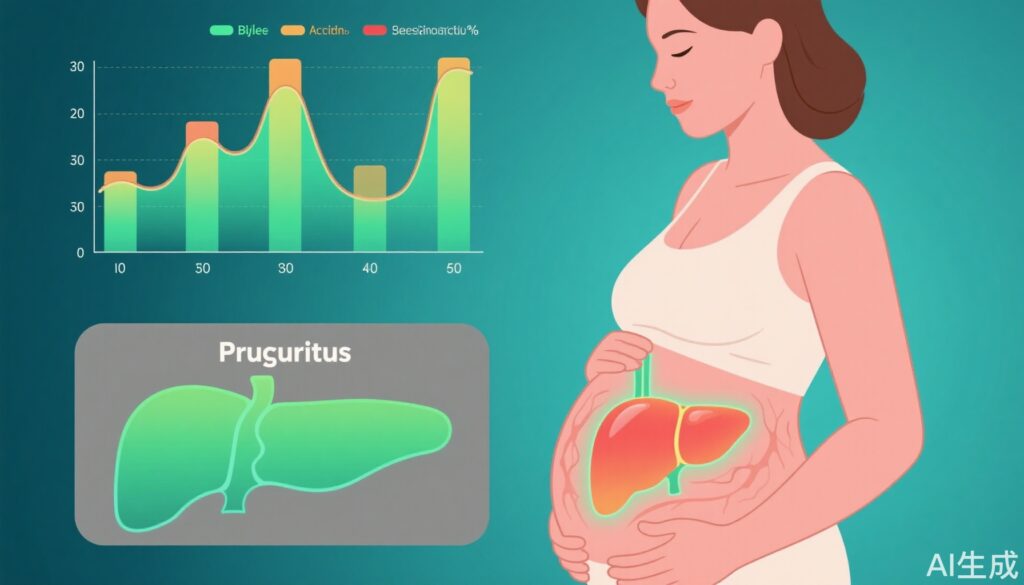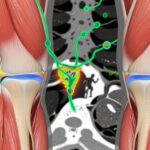Highlight
- Peak bile acid levels and maternal BMI are independent predictors for pruritus severity deterioration in intrahepatic cholestasis of pregnancy (ICP).
- Over half (53%) of women with ICP experience worsening pruritus as pregnancy advances, particularly those with severe ICP (peak bile acids ≥ 100 μmol/L).
- Baseline liver function tests do not reliably predict pruritus progression; dynamic changes in bile acid levels during gestation are more informative.
- Findings stress the importance of individualized monitoring and management strategies for women with ICP, especially those with higher BMI or severe biochemical derangements.
Background
Intrahepatic cholestasis of pregnancy (ICP) is a hepatic disorder specific to pregnancy, characterized by intense pruritus and elevated serum bile acids, typically manifesting in the third trimester. The condition poses significant maternal discomfort and, more critically, is associated with increased risks of adverse perinatal outcomes, including preterm delivery and stillbirth. Pruritus is the hallmark symptom and often dictates the timing and intensity of clinical intervention. Yet, the factors influencing the course and severity of pruritus in ICP remain incompletely understood, complicating risk stratification and management.
Study Overview and Methodological Design
Researchers conducted a longitudinal observational cohort study to elucidate determinants of pruritus severity progression in ICP. The study recruited 139 women from nine UK hospitals and the ICP Support charity over a 23-year period (1997–2020). Inclusion criteria required a diagnosis of ICP; exclusion criteria were not explicitly detailed but can be inferred to align with standard clinical diagnostic thresholds and the absence of alternative cholestatic conditions.
All participants underwent serial measurements of serum bile acids, alanine aminotransferase (ALT), and bilirubin. Pruritus severity was assessed using a 100-mm visual analog scale (VAS), categorized into five levels: none, mild, moderate, severe, and very severe. ICP severity was stratified by peak bile acid concentrations: mild (<40 μmol/L), moderate (40–99 μmol/L), and severe (≥100 μmol/L). The primary endpoint was pruritus deterioration, defined as an increase by at least one VAS category from baseline during gestation. Statistical analysis was robust, employing multivariable regression to identify independent predictors and adjusting for potential confounders.
Key Findings
Among the 139 women, 53% exhibited worsening pruritus during pregnancy. Two key independent risk factors for pruritus deterioration emerged:
- Peak bile acid levels (log-transformed): Odds ratio (OR) 2.36; 95% confidence interval (CI) 1.22–4.56.
- Maternal BMI: OR 2.40; 95% CI 1.20–4.81.
Most notably, women with severe ICP (peak bile acids ≥ 100 μmol/L) had a markedly increased risk of pruritus worsening compared to those with mild ICP (OR 7.45; 95% CI 1.43–38.86). Interestingly, baseline bile acid, ALT, and bilirubin levels did not differ significantly between those who did and did not experience pruritus deterioration; however, both peak and final (last measured) bile acid levels were higher in women with pruritus worsening (P = .01 for both).
Mechanistic Insights and Pathophysiological Context
The pathogenesis of pruritus in ICP is multifactorial and incompletely delineated. Bile acids are thought to act as pruritogens, either directly or via modulation of endogenous mediators such as lysophosphatidic acid (LPA) and autotaxin. The observed association between higher peak bile acids and pruritus deterioration is biologically plausible, supporting the notion that bile acid accumulation exacerbates cholestatic itch through neuronal or cutaneous pathways. The link between elevated BMI and pruritus progression may reflect altered bile acid metabolism, increased systemic inflammation, or pharmacokinetic differences in bile acid clearance among women with higher adiposity.
Clinical Implications
These findings have several direct implications for clinical practice:
- Risk stratification: Women with higher peak bile acids or elevated BMI warrant closer surveillance for pruritus progression and potential escalation in management, including consideration of early delivery if maternal or fetal risks heighten.
- Monitoring strategies: Serial assessment of bile acid levels—not just baseline values—provides more actionable prognostic information for anticipating pruritus course.
- Individualized care: Clinicians should recognize that pruritus severity may fluctuate independently of initial biochemical markers, underscoring the need for flexible, patient-centered care plans.
Limitations and Controversies
The study’s strengths include its multicenter design, longitudinal follow-up, and rigorous phenotyping. However, several limitations merit discussion:
- Sample size and generalizability: While 139 participants is robust for a rare disease, the relatively small cohort and UK-centric recruitment may limit extrapolation to diverse populations.
- Potential selection bias: Voluntary participation via a patient support charity could favor individuals with more severe or symptomatic disease.
- Unmeasured confounding: Factors such as genetic polymorphisms, environmental exposures, or treatment adherence were not addressed.
There is ongoing debate regarding the best biomarkers for predicting maternal symptoms versus fetal outcomes in ICP, and whether more aggressive interventions for pruritus alone are justified in the absence of fetal compromise.
Expert Commentary or Guideline Positioning
Current international guidelines (e.g., Royal College of Obstetricians and Gynaecologists) recommend close monitoring and individualized timing of delivery for women with severe ICP, particularly when bile acids exceed 100 μmol/L. This study adds granularity by highlighting the prognostic value of dynamic bile acid changes and maternal BMI in anticipating symptomatic progression, not just fetal risk.
Conclusion
In summary, this longitudinal cohort study demonstrates that both peak bile acid levels and maternal BMI independently predict the worsening of pruritus in women with ICP as pregnancy advances. Baseline liver function tests alone are insufficient for forecasting symptom trajectory. These data underscore the need for dynamic, patient-specific monitoring and management strategies, while also pointing to possible biological mechanisms that could inform future therapeutic targets. Larger, multiethnic studies and interventional trials are warranted to validate these findings and optimize care for this challenging pregnancy complication.
References
1. Yang X, Williamson NJ, Sajous J, Mitchell AL, Chambers J, Dixon PH, Williamson C, Ovadia C. Characteristics associated with alterations in pruritus severity across gestation in intrahepatic cholestasis of pregnancy: a longitudinal cohort study. Eur J Obstet Gynecol Reprod Biol. 2025 Jul 21;313:114590. doi: 10.1016/j.ejogrb.2025.114590. Epub ahead of print. PMID: 40714624.
2. Royal College of Obstetricians and Gynaecologists. Obstetric cholestasis. Green-top Guideline No. 43. 2011 (updated 2022).
3. Geenes V, Williamson C. Intrahepatic cholestasis of pregnancy. World J Gastroenterol. 2009 May 7;15(17):2049-2066. doi:10.3748/wjg.15.2049.



